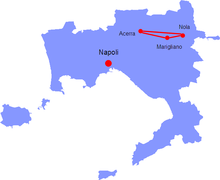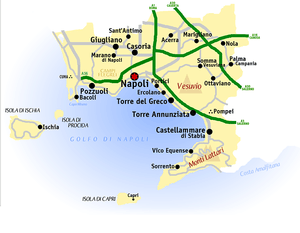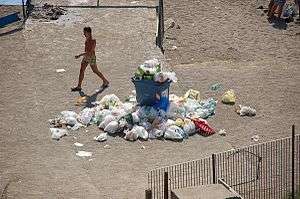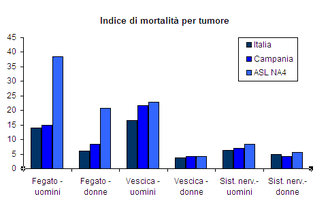Triangle of death (Italy)


The triangle of death (Italian: Triangolo della morte) is an area in the Italian province of Campania comprising the municipalities of Acerra, Nola and Marigliano. The region has recently experienced increasing deaths caused by cancer and other diseases that exceeds the Italian national average. The rise in cancer-related mortality is thought to be mainly caused by pollution from illegal waste disposal by the Camorra criminal organization.
Definition
The term "triangle of death" was first used with regard to the region in an August 2004 scientific publication.[1][2][3]
An estimated 550,000 people live in this area. The annual death rate per 100,000 inhabitants from liver cancer is close to 34.5 for men and 20.8 for women, as compared to the national average of 14. The death rate for bladder cancer and cancer of the central nervous system is higher than in other European countries, although by a more modest increment. Campania, overall, has a lower-than-average cancer mortality rate than Italy.
The high death rate is thought to be due to illegal and improper hazardous waste disposal from various sources, especially from the industries of northern Italy, carried out by Camorra.[4] The Lancet Oncology article noted:
Today, the difference between lawful management of waste and illegal manipulation with regard to their compliance with health regulations is very narrow, and the health risks are rising.— Alfredo Mazza, The Lancet Oncology, vol. 5, September 2004
and
The 5000 illegal or uncontrolled landfill sites in Italy drew particular criticism; Italy has already been warned twice for flouting the Hazardous Waste Directive and the Landfill Directive, and the EU has now referred Italy to the European Court of Justice for further action.— The Lancet Oncology, vol. 5, September 2004
Epidemiological research by the World Health Organization
| Cancer death rate | ||||||||||||||||||||||||||||
|
In the following table, the death rate for every more common cancer that appear in the triangle of death, is reported. These data are according to the study published by The Lancet Oncology.
|
In 2007, research[5] conducted by the World Health Organization, Italian Istituto Superiore di Sanità, Consiglio Nazionale delle Ricerche and Campania Region collected data on cancer and congenital abnormalities in 196 municipalities covering the period between 1994 and 2002 found abnormally high disease incidence. These abnormal patterns may correlate to areas where there are uncontrolled waste sites. However, this work also highlighted the difficulty in determining causality and in establishing a link between increased death and malformation rates and waste disposal.
Illegal toxic waste dumping in Campania
The boss of the Casalesi clan, Gaetano Vassallo, admitted to systematically working for 20 years to bribe local politicians and officials to gain their acquiescence to dumping toxic waste.[6][7] Giorgio Napolitano, President of Italian Republic, said on June 2008:[8][9]
It is certain, not only to citizens but to the government as well, that the systematic transfer of toxic waste from industries in Northern Italy to Campania, was committed by the Camorra— Giorgio Napolitano, 4-06-2008.
Dangerous pollutants such as dioxins, are found in the area, particularly around Acerra,[10] as well as illegal waste disposal,[11] even in the business district of Montefibre.[12] As early as 1987, a decree of the Ministry of Environment marked Acerra "at high risk of environmental crisis".[13]
High levels of polychlorinated biphenyls (PCBs) were detected both in the soil and in the inhabitants of the region, though no obvious emitters are known.[14] It is hypothesized that industrial slurry originating from Porto Marghera (industrial docklands near Venice) was disguised as compost and spread on fields in the Acerra countryside by the Casalesi clan, often with help from the landowners.[15][16]
In one case, a company had its assets seized during a 2006 investigation[17] in which it was alleged that the company had illegally disposed of waste from industries in the regions of Veneto and Tuscany in the territories of Bacoli, Giugliano and Qualiano. Approximately one million tonnes of toxic waste are said to have been disposed of, earning €27 million. The company was already the subject of a 2003 investigation.[18] In another case, a tank full of toxic substances was found buried in an illegal dump, in Marigliano.[19][20]
The illegal burning of waste, for example to recover copper from wiring,[21][22] is known to release dioxins into the atmosphere of Earth. Such fires are easily hidden among legitimate incineration resulting from the more general waste disposal problem, and the illegal burning of hazardous materials was particularly noted during 2007 and 2008. Between January and March 2007, 30,000 kilograms of waste were burned on agricultural land, with a revenue of more than €118,000.[21] The presence of fires in the north area of Naples led author Roberto Saviano to use "Land of fire" (terra dei fuochi) as chapter titles in his book Gomorrah.[23]
Hazardous industrial waste disposal may happen in lawful landfills, too. In 2000, a Parliamentary Commission enquiry about waste[24] discovered some 800,000 tonnes of mud in Pianura landfill, coming from ACNA of Cengio[25][26] in Naples, and the Italian Procura della Repubblica found (through telephone wiretappings) some irregularities in the waste disposal into the landfill of Villaricca, managed by FIBA (a company of the Impregilo group).[27]
Opposition to landfills

In 2008 the waste commissioner Guido Bertolaso, (the head of the civil protection department), planned to open a landfill but this was opposed by Chiaiano's residents,[28] because of mistrust of the governing institutions and the awareness of the population of the rise in cancer death rate.
There was similar resistance in Pianosa to reopening a closed landfill proposed by government commissioner Giovanni De Gennaro. In 2007 and 2008 some of the protests turned violent,[29] particularly in Naples and the suburbs of Quarto and Pozzuoli. It is alleged that there was collusion between local political interests and organised crime over building interests.[30][31]
The incinerator of Acerra was also seen as potential source of pollution and stirred conflict and debate in the local area.[32]
Pollution and agriculture exports
The agro-economy of the region has been adversely affected by the allegations. In March 2008,[33] dioxin were found in buffalo milk from farms in Caserta. Countries such as South Korea and Japan identified this pollution and subsequently banned imports of buffalo milk from the region. While only 2.8% of farms in Campania were affected,[34] the sale of dairy products from Campania collapsed in both domestic and global markets.[35][36][37]
Literature and film
The issue was raised by Roberto Saviano in his book Gomorrah and in the film of the same name. It was also the subject of a documentary by Esmeralda Calabria and Andrea D'Ambrosio entitled Biùtiful cauntri.
See also
- Camorra
- Ecomafia
- Environmental racism in Europe
- Naples waste management issue
- Gomorrah (book)
- Gomorrah (film)
- Biùtiful cauntri
- Radioactive waste dumping by the 'Ndrangheta
Notes
- ↑ Senior K, Mazza A. Italian "Triangle of death" linked to waste crisis. Lancet Oncol. 2004 Sep;5(9):525-7. PMID 15384216
- ↑ "Il triangolo della morte". rassegna.it. March 1, 2007. Archived from the original on 2009-02-15. Retrieved 2015-11-19.
- ↑ "Discariche piene di rifiuti tossici quello è il triangolo della morte". la Repubblica. 2004-08-31. Retrieved 2008-09-26.
- ↑ "Bolle false e finti trattamenti così camuffiamo i veleni". la Repubblica. 2008-06-06. Retrieved 2008-09-29.
- ↑ Look at review into the review Trattamento dei rifiuti in Campania: impatto sulla salute umana dell Organizzazione Mondiale della Sanità, Istituto Superiore di Sanità, Consiglio Nazionale delle Ricerche e Regione Campania.
- ↑ "Così ho avvelenato Napoli". l'Espresso. 2008-09-11. Retrieved 2008-10-24.
- ↑ "Inchiesta sui veleni a Napoli perquisiti l'Espresso e due reporter". la Repubblica. 2009-09-12. Retrieved 2008-09-26.
- ↑ "Napolitano: "Rifiuti tossici arrivati in gran parte dal nord"". la Repubblica. 2008-06-04. Retrieved 2008-10-24.
- ↑ "Rifiuti, l'allarme di Napolitano: "Quelli tossici provengono dal Nord"". la Stampa. 2008-06-04. Retrieved 2008-09-29.
- ↑ ambienti, ed. (2007-09-18). "Diossina ad Acerra, analisi fai da te". il Manifesto. Retrieved 2008-10-01.
- ↑ "Morire di diossina nel paese dei rifiuti Ricerca dell'Oms Qui il cancro uccide trenta volte di piu". la Stampa. 2007-05-07. Retrieved 2008-10-24.
- ↑ Roberto Saviano (2004-08-27). "Acerra, polmone di cemento". Retrieved 2007-10-01.
- ↑ D.C.d.M. 26-02-1987.
- ↑ "Diossina, la Lilt cerca fondi per le analisi dei cittadini di Acerra, Nola e Marigliano". it:Corriere del Mezzogiorno. 2008-03-14. Retrieved 2008-10-06.
- ↑ "Dal nord rifiuti industriali in provincia di Caserta". caffenews. Reuters. 2008-02-25. Retrieved 2008-10-24.
- ↑ "Campania, scoperto traffico illecito dei rifiuti. L'attività di smaltimento gestita dai Casalesi". Ecostiera. 2008-02-25. Retrieved 2008-09-29.
- ↑ "Rifiuti, sequestro al gruppo Pellini". il Nolano. 2008-09-23. Retrieved 2008-10-01.
- ↑ "Complicità ed emergenza rifiuti dietro il traffico illecito scoperto in Campania". VAS Campania. 2006-01-24. Retrieved 2008-10-01.
- ↑ "Striscia la notizia: i veleni di Marigliano". Marigliano. 2008-02-27. Retrieved 2008-10-06.
- ↑ Look at video by Striscia la notizia (italian TV information)
- 1 2 "Rifiuti, i veleni tra i campi verdi di Caivano, Afragola e Casoria". Ecostiera]. 2008-10-25. Retrieved 2008-10-01.
- ↑ "Afragola, scoperti 50 quintali di veleni vicino al cimitero. È allarme diossina per i roghi.". Napolinord]. 2008-09-14. Retrieved 2008-10-01.
- ↑ Peppe Ruggiero (2006-09-29). "La terra dei fuochi a nord di Napoli". Nazione indiana. Retrieved 2008-11-06.
- ↑ "Commissione parlamentare d'inchiesta sul ciclo dei rifiuti e sulle attività illecite ad esso connesse".
- ↑ "Anche i fanghi dell'Acna di Cengio tra i veleni sepolti sotto quella collina". la Repubblica. 2008-01-22. Retrieved 2008-10-24.
- ↑ "Commissione parlamentare d'inchiesta sul ciclo dei rifiuti e sulle attività illecite ad esso connesse".
- ↑ "La discarica è piena di liquido se sale sarà come un Vajont". la Repubblica. 2008-05-29. Retrieved 2008-09-29.
- ↑ "Noi non siamo N.I.M.B.Y.". chiaiaNodiscarica. Retrieved 2008-09-30.
- ↑ "Pianura, scontri alla discarica assaltata anche un'ambulanza". la Repubblica. 2008-01-05. Retrieved 2008-10-01.
- ↑ "Rifiuti, per gli scontri a Pianura oltre trenta arresti a Napoli". la Repubblica. 2008-10-06. Retrieved 2008-10-06.
- ↑ ""Arrivano i Carabinieri". Così Nugnes avvertiva i rivoltosi". la Repubblica. 2008-10-07. Retrieved 2008-10-08.
- ↑ "Protesta contro i rifiuti ad Acerra continua il presidio alla stazione". la Repubblica. 2004-09-11. Retrieved 2008-10-01.
- ↑ "Mozzarella, limitate positività alla diossina. Il Governo dopo l'alt di Tokyo: no a psicoosi". Corriere della sera. 2008-03-26. Retrieved 2008-10-06.
- ↑ Consorzio di tutela del formaggio mozzarella di bufala campana DOP (2008-04-20). "Comunicato stampa". Retrieved 2011-01-13.
- ↑ "Mandara: Mozzarella sana, ma vendite in calo". Il Denaro. 2008-01-23. Retrieved 2008-10-06.
- ↑ "I prodotti tipici non si vendono più, la Cia: Rischio tracollo". Il Denaro. 2008-01-15. Retrieved 2008-10-06.
- ↑ "La spesa al tempo dei rifiuti "Prodotti locali? No, grazie"". La Repubblica-Napoli. 2008-01-16. Retrieved 2008-10-06.
Bibliography
- (English) Kathryn Senior and Alfredo Mazza, Italian “Triangle of death” linked to waste crisis, The Lancet Oncology, Volume 5, Issue 9, September 2004, Pages 525-527.
- (Italian) Translation by The Lancet Oncology from the site of Centro Nazionale di Epidemiologia, Sorveglianza e Promozione della Salute
- (English) Fabrizio Bianchi et al., Italian “Triangle of death”, The Lancet Oncology, Volume 12, Issue 5, December 2004, Page 710.
- (Italian) Trattamento dei rifiuti in Campania: impatto sulla salute umana, report by World Health Organization, Italian Health Institute, it:Consiglio Nazionale delle Ricerche e Regione Campania (Italia).
In television
- Report: Terra bruciata, TV 9-3-2008, and how finished this story in: Come è andata a finire?.
- Repubblica Radio TV: Morire di diossina in Campania, del 28-12-2007: , ,
- La 7: Il cancro di Napoli, del 12-12-2007; Allarme cibo avvelenato, Exit del 18-12-2007; Il posto dei rifiuti, del 22-09-2007
- Tg1: interview to Roberto Saviano at 3-1-2008 (evening ediction at 8:00 p.m.)
- Sat 2000: interview to dott. Antonio Marfella, oncologist at "Formato famiglia, 20-12-2007
External links
- La Terra dei fuochi, website showing claims on illegal waste disposal in Campania
- La Terra dei fuochi, website on "triangle of poisons" Giugliano-Qualiano-Villaricca
